![[A-08s - front view]](../jpg/a08s_front.jpg)
Product: Yamamoto A-08s Single-ended '45' Power Amplifier
Manufacturer: Yamamoto - Japan
Cost, approx: 2500 Euro (YMMV)
Reviewer: Geoff Husband - TNT France
Reviewed: November, 2009
![[A-08s - front view]](../jpg/a08s_front.jpg)
Here we arrive at second of my 'anything-but-300b' single-ended amplifier tests. The first featured was the Ayon Crossfire integrated and anyone reading that review will see what an impression it made on me... As I said at the outset, the idea behind the series was to see what performance was available from alternatives to the now almost ubiquitous Western-Electric 300b valve and it's more recent clones. The relevant word there is 'performance' I'm not looking for amplifiers that offer particular high output compared to the 8-10 Watts of a typical 300b running solo. No the main criterion is the sound quality nothing more, nothing less. In this search I'm aided by my own speakers the Loth-x Polaris horns, which with a very valve friendly impedance curve and massive efficiency well beyond 100 dbl allow even the most flea-powered amplifier to sing with headroom to spare.
But there was a second reason for my looking at the alternatives to the 300b, and that is the sheer cost of running such a beast. This became a personal issue last year, when my Opera/Cyber 300b PSE amps ate two pairs of Full-Music mesh-plate 300b's this after 18 months of (admittedly heavy) use. Now as those amps use a pair of 300b's running parallel per side I was looking at least £300 for a revalve even using the cheapest 300b's available. To replace with similar quality valves pushed the bill to around £800, getting silly with genuine WE's could double that and don't even think about NOS valves!
Granted my own amps double the costs, but if typical, even a single 300b amp could cost the owner £300 plus a year to keep in glass.
I guess it was ironic that having put sound performance as no1 priority and cost as an interesting and important aside I'd end up starting the series with an amp more powerful than my Operas and which ran a pretty expensive valve the Ayon! Ho hum...
So here we cut to the chase with a valve that in theory addresses both those issues. The RCA 45 could be seen as a baby 300b, and some people will tell you it's the best sounding of all single-ended triodes out there. Another refugee from the 1930's it's other big attraction is that not only are new valves available at well below 300b prices, but more importantly there are thousands of NOS and 'used but good' valves of various flavours and for £75 a pair and up. The downside is that the output in SE mode is a measly 2.5 Watts, but as I've already said that is irrelevant to the tests...
Which brings us round to the subject of this review the Yamamoto A-08s power-amp. I found this whilst doing the usual Google trawl of websites in preparation for this season. Stumbling across this website was like finding a mint 'Pepper' in a charity shop an eclectic mass of hi-fi products and components; valve bases, cartridge tags, speaker cabinets, binding posts, transformers, cones, cartridges, phono stages, amplifier kits you name it!* What interested me most were some stunning looking valve amps using various triodes including several I'd never heard of... But it was the A-08s that caught my eye as using a widely available and respected valve, and which looked pretty good value.
So a few emails and said amp was delivered and unwrapped chez moi...
The box wasn't of the backbreaking variety that I'd become used to with 300b amps, and especially the near hundredweight of the Ayon Crossfire. But then the RCA 45 doesn't require the massive transformers of those much larger valves.
But opening up the box revealed a pretty little amp whose sheer quality of finish was a joy to behold. Most amps nowadays have a well finished casework, aluminium extrusions and modern CNC machines have banished forever the kind of biscuit-tin many expensive amps used to come in. But here we're a step beyond that because the dominating feature is a simply beautifully machined (or should it be 'carved') slice of what looks like rosewood. Come on, get down on your knees and look really, really closely... Those tiny vent holes around the valve sockets, the silky feel to the varnish, real ebony legs supporting the thing damn if this had a £5,000 price tag you wouldn't be surprised. The simple champagne metal transformer cover fitted perfectly shut-lines of a Mercedes(or should it be Lexus?).
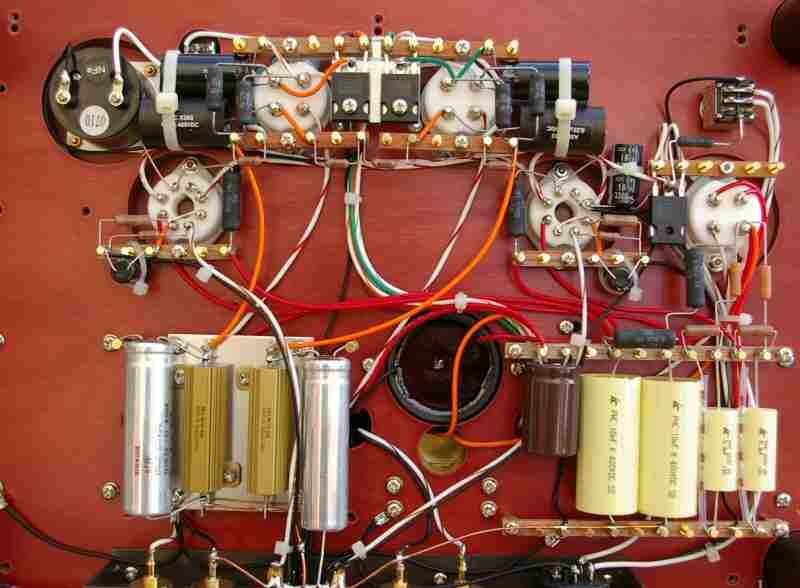
This sort of thing isn't easy to do, but what is even more impressive is that this quality extends everywhere, and one reason is that practically everything is made in-house. The teflon valve bases, the really chunky and easy-to-use binding posts and sockets, all as good as it gets. The speaker binding posts have a greater diameter than usual allowing you to really torque those cables down. The exquisite bias meter that allows you to check the health of each valve... Then inside... Just look at the pics guys, gorgeous neat layout, all point-to-point and not only quality components, but who in a £2000 amp damps custom capacitors in an ebony sleeve? Then the transformers, cut-core beauties that though not massive for a 300b are plenty big enough for a '45'.
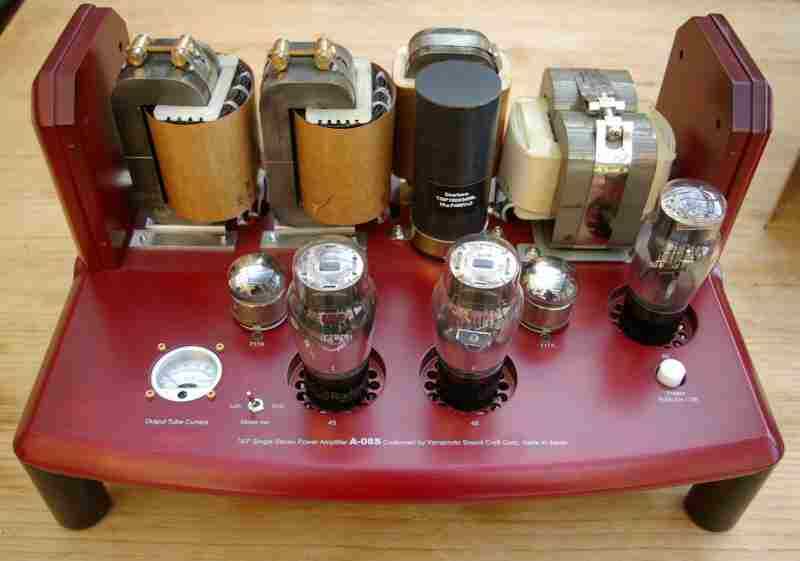
OK I'm getting carried away, but lets put this in perspective. A few years ago I reviewed the Wavac 300b am and very nice it was too. It has quite a family resemblance to the Yamamoto as well, with it's combination of wood and champagne. But good though the finish was, the Yamamoto is better more intricate, the fit better, no bent tin, no gaps between panels, more 'polished' somehow and the internal quality just more special. Good though the Wavac is the Yamamoto made it look like a cheaper amplifier.
The Wavac cost £5000...
And as for my own amps a monster pair of beautifully designed Opera monoblocks costing more than three times the Yamamoto, even here I still found myself falling for the sheer integrity of this little amp and the man responsible for it has reason to be very proud of his work.
Of course the icing-on-the-cake is that the Yamamoto comes equipped with all NOS valves, genuine RCA '45's, a matching (because they were designed and used together frequently in the past) shouldered-bottle '80' rectifier and a pair of unusual 717A mini doorknobs for driving purposes.
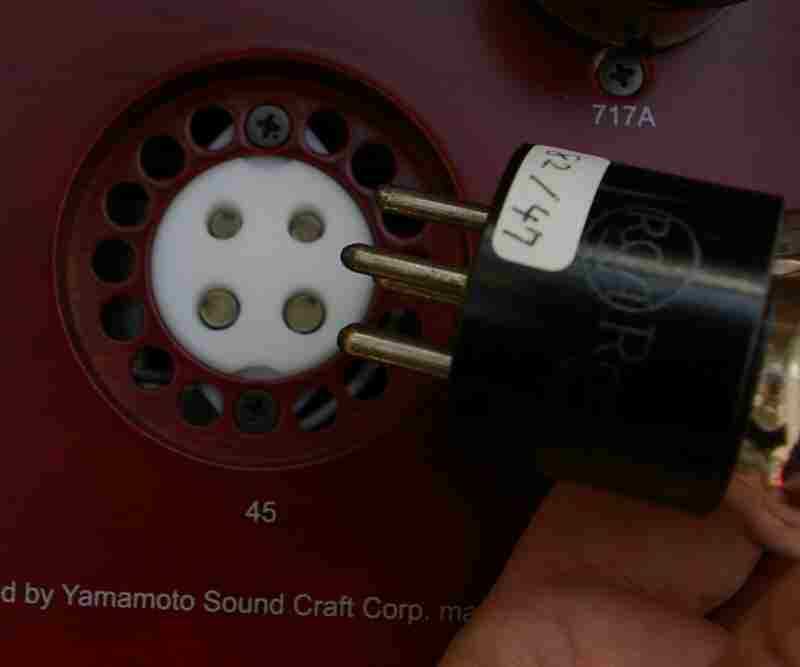
'Never judge a book by it's cover'
Sheesh! I can hear my mum saying that now. But when someone who obviously knows what they are doing lavishes those kind of production values on his baby, both inside and out it'd be a surprise if the result was poor...
And now - as so often seems to happen when I try to do pseudo scientific comparisons the wheels come off... The problem is that the Yamamoto needs a pre-amp. You cannot test it in isolation, but only as a combination. Three months ago that wouldn't have caused me a moments pause. I had two very fine, all-valve pre-amps available the Opera Cyber 222 (my own) and the Acoustibouy Scorpio, a pre-amp costing twice the asking price of the A-08s on its own and in quality as near as dammit to my old Audionote M3 which doubles the anti again!
Great, just wire those pre's up and see which matched best and on with the test. Except that the Ayon Crossfire that had just been cruelly ripped from my clutches had changed my view of both. The Ayon had the capability to be run direct as a power-amp bypassing all its switching and pre-amp stage. In fact I'd planned to review it primarily run this way. Oh how foolish, because from the first instance it was obvious that the Ayon was noticeably more transparent run as an integrated. The mighty M3 gave it a bit more clout and power, but at the cost of silken veil (clichι alert...) being draped in front of the music and a raising of the noise floor. The other two worthy Pre's added nothing, but took a step back from the music in both cases. The Ayon was superior in all cases when run naked.
I know this is getting ahead of myself, and to draw the conclusion that the Yamamoto is as good as the Ayon run as a power-amp is an odd statement at this stage of a review, but I hope you see my dilemma. The Yamamoto is so transparent that it is capable of stripping bare the effect of every component preamp, cables, connections, that you place between it and the source. So anyone reading this review must be aware that as far as I am concerned the lead that the Ayon has sonically over the Yamamoto may be purely and simply because of the superiority of the Ayon's pre-amp section (or the intrinsic advantages of an integrated).
Perhaps at this point it'll more apposite to move the debate away from the Crossfire and compare the A-08s with the various 300b amps I've had through my clutches.
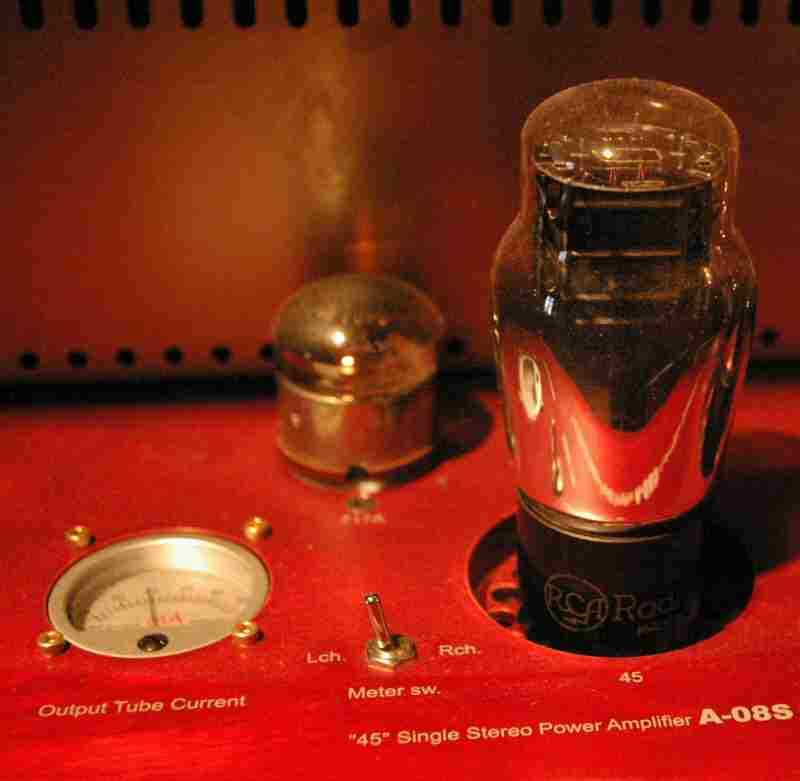
First off is that it's quiet almost transistor quiet. The slightest hum betrays that something is going on, but in this respect it is superior to all the 300b amps I've had here** to an embarrassing degree in some cases. This might be seen as a minor attribute, but if you are going to make the most of 2.5 Watts you need very efficient speakers, and those in turn are going to make low background noise critical. In two cases I've had SE 300b amps arrive on test and had to return them so intrusive was the background noise.
The Yamamoto did benefit from the comparison with the Ayon in one other respect as it, along with that amp, showed the 300b's to have a slight warm gloss to the sound, not so much as an overall tonal shift as the faintest sprinkling of fairy dust. I can see how this could be attractive but in the end it still gave the impression of being an addition present on all recordings. In contrast the 45's just sounded as clean as you could wish, seemingly adding nothing.
The other common factor was the ability to be open, tuneful and lightening fast in the bass. I don't want anyone to go away thinking that I subscribe to the commonly held notion that SE's generally and 300b's in particular are soft and woolly in the bass. This myth derives from using inappropriate speakers; a decent horn produces a bass wavefront that will make you blink, but the fact remains that the A-08s just seemed that bit tighter and faster. 80's disco/pop is nothing without this ability and listening to something like Jackson's 'Billy Jean' showed that superiority in speed and leading edge definition that left the 300b's I've heard sounding just a little bit plodding. The Ayon, even run as a power-amp managed to pull even further ahead in this respect, but as such workouts left me hyperventilating with the Ayon that's hardly a criticism of the little Yamamoto.
300b's are all about midband and the very best 300b amp I've heard in this respect, the Audionote Quest Silvers, are truly transparent, but the A-08s matched, no let's not mess about, I think it even pulled out a tiny lead here. In comparison the Audionotes again have that feint sheen, the Yamamoto also gave a drier and slightly faster bass performance, though the Audionotes had slightly more weight.
With such an open and clear mid-band small treble details that often get lost were clear as a bell (pun intended). Modern producers love to put all sorts of tinkly-bits in the background of songs to justify their pay and sometimes this can even work to the benefit of the song. At the same time this gives space for the music to breath in a wide acoustic. This ability, especially in depth wasn't intrusive or etched, it just seemed to give some of the better multitracked recordings the room to make sense. At the same time it allows some rather muddy recordings - Jeff Beck's 'Modern Guilt' being a prime example to open up and become musical, it even made 'Exile on Main Street' come out of the swamp!
This transparency made ancillaries critical as well it quite clearly showed the Acousticbouy pre-amp to be superior to the Cyber-222, the former displaying an extra layer of really low-level detail. Then mid-review the new SME V12 arm turned up. This new flagship SME comes complete with a silver arm cable, but in initial set-up I just wired in the generic cable I'd be using previously. The result was fine but the improvement when I plugged in the supplied cable was quite extraordinary. I'm not a huge cable fan, but the Yamamoto made the difference all too obvious. Prompted by this I spent more time than was healthy fiddling about with cables even how they were laid out and even started messing about with the order things were plugged into the gang-socket (inconclusively), but this sort of obsession only comes when something encourages you to drag the last ounce from it and this the Yamamoto certainly did.
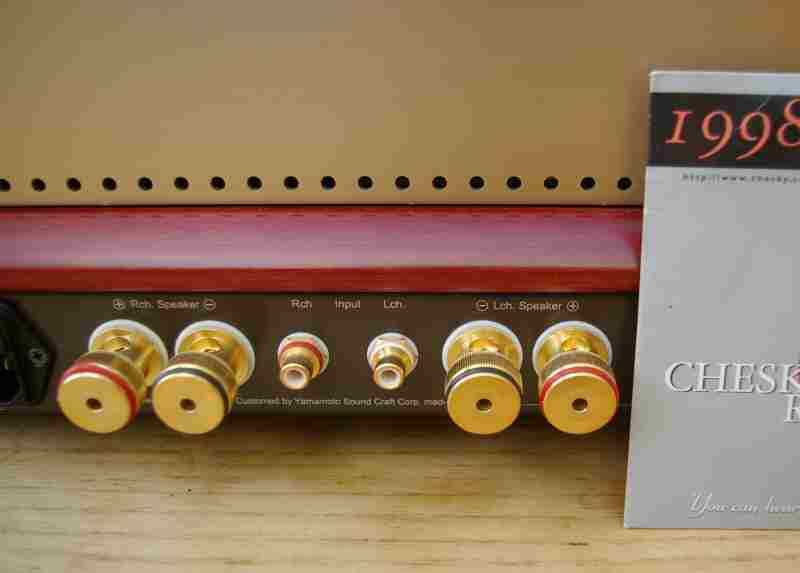
As I write I'm listening to my old ASV vinyl copy of 'Rapsody in Blue' with the RPO conducted by Andrew Litton in 1987. A DMM recording, and one of the better ones, this is a favourite because it demands so much from a system within just a few seconds of the opening. The 'Gross Caisse' is one of the few instruments that really does produce fundamentals below 40 Hz and then a few seconds later a splash cymbal is being beaten to death. Add a clarinet (my wife plays one as well so I know what they sound like) - one of the most difficult instruments to get right this side of female vocal and the piano, and it's quite a work-out... Oh and then there's the piano:-) Unlike many classical pieces it also lives-and-dies on it's timing (being jazz based).
In fact listening now I can't think of a better test record rasping brass one second, hammered percussive piano the next then frequently a solo instrument followed by an orchestral climax it's the sonic equivalent of an Iron-Man triathlon... Any reviewer with this and Nina Simone's 'My Baby Just Cares for Me' has pretty much every base covered...
And I have to say that the little Yamamoto is just cruising through it without breaking sweat. When the bite of a cornet is needed it's there, ditto holding the whole kit and caboodle into some coherent whole at the brass led climax at the end. The acoustic is realistic without making you feel it's been recorded in a swimming baths.
So to Nina... A 50 year old mono recording complete with tape hiss and a hint of amp hum that should have 99% of the current music recording industry holding their heads in shame. The Yamamoto treats this museum piece with the care of a master curator, showcasing one of the great voices and somehow (in mono) generating a beautiful ambience/acoustic at the same time as being able to pull 'audiophile' detail like the 'wood' of the piano keys hitting the stops.
It's hard to actually catagorise the Yamamoto's contribution to all this because everything just seems to be coming out perfectly, my attention isn't being drawn to one particular attribute, I'm just revelling in the ease and even-handedness of the amp. In my experience only the Ayon has been more balanced and transparent but at 4x the cost, and as I've made clear I'm not at all sure that this isn't down to limitations in the pre-amps used. I'd also say that the Yamamoto is very close in presentation generally to the Ayon, certainly closer than the 300b amps I've heard.
Later Much Later...
A short addenda to the review the amp stayed with me for longer than usual, partly because I was having such fun with it. After 2months of use (and after the above was written) two things happened. Firstly the amp became quieter still, pushing the noise level low enough for even lower level signals to come clean. That such a good amplifier could get even was very gratifying, but it does bring up an interesting dilemma. For many reasons I usually use components for a few weeks, the manufacturers want them back, and usually there's something else in the queue waiting for review. This time I had the amplifier much longer and this was to the benefit both of the accuracy of this review, and obviously to the manufacturer...
The second change was the arrival of a little transistor Pre-amp from KingRex. This just dovetailed so beautifully with the A-08s, being even more transparent than the much more expensive valve amps I had to hand sacrilege I know... Not only did this bring the A-08s even closer to the Ayon, but the pairing dropped the total cost to below 4000 Euro
Having gone on about the perfection in build, the one glitch is the on/off switch. It's an illuminated button on the top of the wooden chassis which allows very easy access, so you have the choice of easily turning the thing off (other valve amp manufacturers take note!), but it does feel a little less than well-oiled. That this is the only thing I can think to gripe about speaks volumes...
The valves show their age sometimes by producing the odd 'flutter', but I've had this with new valves too, and it's a problem that seems to get less as time goes on and those old bones are woken up.
Well the 2nd amp in the series and another resounding hit, and with a very similar set of attributes. But in this case it's a lot more accessible to all with a price, both purchase and running, well below 300b equivalents. The one proviso is that in order to get the best from the amp you need seriously efficient speakers with valve friendly characteristics. I'd look at 96 dbl as a fair minimum. That makes the Yamamoto less compatible than a 300b, though in fairness you still need specialist speakers to make them sing as well.
So I'm charmed again, the sheer integrity of the design, in build quality, design and performance leave precious little to criticise, and at the price nothing. Yes, I still think the Ayon even more transparent and with more overt dynamics, but that amp costs nearly four times as much - I'm well impressed I like things that deliver more than you expect and the A-08s certainly did this for me.
*No-one was more surprised than me to find Mark had found the same site and was busy reviewing their component supports!
** You can find the list of those 300b amps in the review section...
|
|
© Copyright 2009 Geoff Husband - www.tnt-audio.com